- Our School
- Our Advantage
- Admission
- Elementary•Middle School
- High School
- Summer
- Giving
- Parent Resources
- For Educators
- Alumni
« Back
Help Your Struggling Learner: Remediation Is a Key to Success
November 1st, 2017
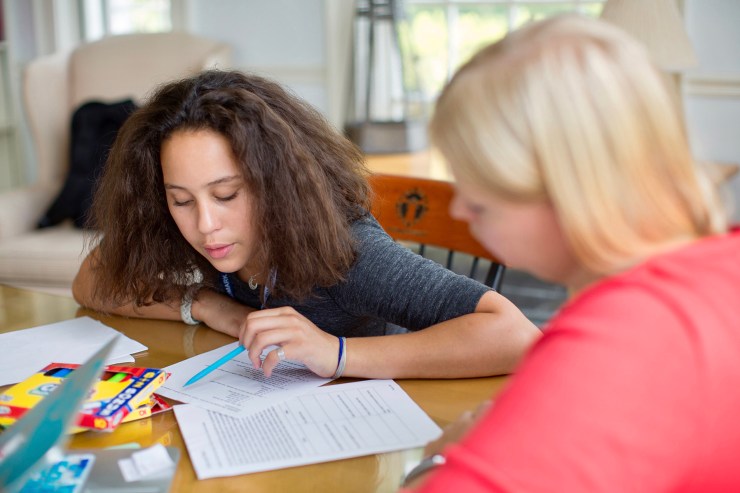
This is part three of the five-part series, What Is a Language-Based Learning Disability?
We know that 15%–20% of the population has a Language-Based Learning Disability (LBLD), such as dyslexia, and that students with LBLDs learn differently and need to be taught differently. There are two primary approaches to teaching students with these learning differences: accommodation and remediation.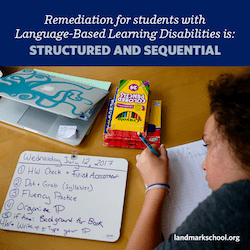
- Accommodations: Allow "a student to complete the same assignment or test as other students, but with a change in the timing, formatting, setting, scheduling, response and/or presentation."1 In other words, accommodations are intended to help kids learn the same material and meet the same expectations as their classmates2.
- Remediation: The student is taught strategies through a structured, sequential, multisensory approach that enables them to acquire academic skills in reading, spelling, and oral and written language.
Accomodations
Accommodations vary by student and come in many forms. Common types of accommodations include:
- Presentation: Material is presented visually, orally, in large print, or with the use of assistive technology.
- Exams and Assignments: Students can dictate their answers using technology or a scribe or type them.
- Setting: Students are allowed to sit in an area of a classroom that benefits their learning style or take exams in small groups or individually.
- Time: Students are given extended time to complete exams and assignments.
- Assignments: Students may receive help with homework or reduced assignments, and exams and projects may be adapted.
Remedial Approach
Alternatively, students who are offered a more remedial teaching approach in a one-to-one or small-group setting can achieve academic success that they never thought possible. A 2009 study by the Johns Hopkins University School of Education’s Center for Research and Reform in Education, called a one-to-one tutorial model for reading instruction the “gold standard” of remedial instruction for struggling readers 3.
Examples of effective remedial instruction include Landmark's Six Teaching PrinciplesTM: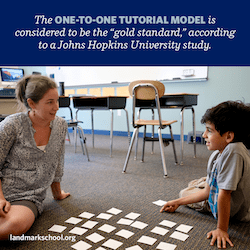
- Multisensory approach: Present information to students via three sensory modalities: visual, auditory, and tactile.
- Micro-unit and structure tasks: Break information down into its smallest units and provide clear guidelines for all assignments.
- Provide models: Present students with concrete examples of what teachers expect.
- Include the student in the learning process: Involve students in the learning process so they become aware of how they learn and why certain skills benefit them.
- Provide opportunities for success: Teachers give students whatever structure is necessary to help students be successful, such as study guides, templates, and guidelines.
- Review and practice: Provide ample opportunities for students to repeat and review learned material.
Designing an effective remedial approach to instruction depends upon an accurate assessment of the student’s cognitive ability and academic skill level. Knowing the student’s learning profile enables educators to teach to the student’s areas of strength and effectively remediate the areas of weakness or difficulty.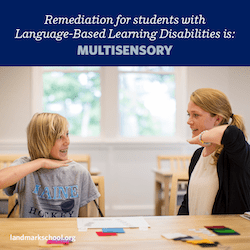
In her book, Overcoming Dyslexia, Dr. Sally Shaywitz describes this as the student’s “sea of strength”4.
“Whatever those strengths are—the ability to reason, to analyze, to conceptualize, to be creative, to have empathy, to visualize, to imagine, or to think in novel ways—it is imperative that these strengths be identified, nurtured, and allowed to define that child”5.
Benefits of Remediation
Extensive research supports the efficacy of remedial instruction and has informed instructional design and practice, which have been proven to be particularly effective for students with LBLD.6,7,8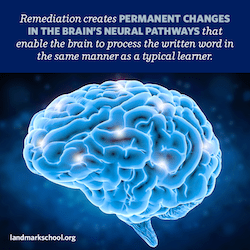
The development of functional magnetic resonance imaging (fMRI), which measures brain activity, has enabled researchers to observe the effects of remedial approaches, particularly reading instruction, in children with LBLDs. The research indicates that reading remediation, especially at an early age, creates changes in the brain’s neural pathways that enable the brain to process the written word.
Early intervention for students with LBLD is a key factor in maximizing the student’s success; kindergarten and first grade are the optimal times to begin remediation. Part four of the “What Is a Language-Based Learning Disability?” series address early intervention.
Reaping the Rewards of Remediation
Remediation is most successful when teachers have received highly specialized instruction and are proficient in the remedial reading program(s) they are using. Although this is not always possible, students should receive remedial instruction four to five days per week until the student is able to read fluently at grade level.
While accommodations can offer some support for students with LBLD, research clearly supports effective remediation as the best pathway to ensuring a student’s success as a reader and as a student.
- Understood.org. The Difference Between Accommodations and Modifications [webpage]. Retrieved from https://www.understood.org/en/learning-attention-issues/treatments-approaches/educational-strategies/the-difference-between-accommodations-and-modifications.
- Wright's Law. School Accommodations and Modifications [webpage]. Retrieved from http://www.wrightslaw.com/info/sec504.accoms.mods.pdf.
- Slavin, R.E., Lake, C., Davis, S., & Madden, N. (2009, June). Effective Programs for Struggling Readers: A Best Evidence Synthesis. Baltimore, MD: Johns Hopkins University, Center for Data-Driven Reform in Education.
- Shaywitz, Sally. (2005). Overcoming Dyslexia. New York, N.Y. Vintage (p. 57).
- Shaywitz, Sally. (2005). Overcoming Dyslexia. New York, N.Y. Vintage (p. 172).
- National Center for Biotechnology Information, U.S. National Library of Medicine. Phonological Remediation Program in Students with Developmental Dyslexia [webpage]. Retrieved from https://www.ncbi.nlm.nih.gov/pubmed/18408861
- National Center for Biotechnology Information, U.S. National Library of Medicine. Phonological Remediation Program in Students with Learning Difficulties [webpage] Retrieved from https://www.ncbi.nlm.nih.gov/pubmed/21552727
- National Center for Biotechnology Information, U.S. National Library of Medicine. Performance of School Children with Specific Reading Disabilities in a Remediation Program [webpage]. Retrieved from https://www.ncbi.nlm.nih.gov/pubmed/15609581
About the Author

Christine Ozahowski is the former Associate Director of Admission at Landmark School.
What Is a Language-Based Learning Disability? Five Part Series
This is part three of the five-part series, WhatIs a Language-Based Learning Disability?
Part One:What We Know About LBLD and Learning, by Bob Broudo
Part Two:Language-Based Learning Disabilities: A Primer, by Melody O'Neil
Part Three: Help Your Struggling Learner: Remediation Is a Key to Success, by Christine Ozahowski
Part Four:It's a Myth That Young Children Cannot Be Screened for Dyslexia, by Nadine Gaab, PhD
Part Five: Language-Based Learning Disabilities on the Homefront, by Angela Timpone Gowans
![]()
Landmark360.org's post by Bob Broudo about LBLD and Learning won a 2017 Gold InspirED School Marketers Brilliance Award in the national competition that recognizes excellence in private and independent school marketing and communications.
Posted in the category Learning Disabilities.






















